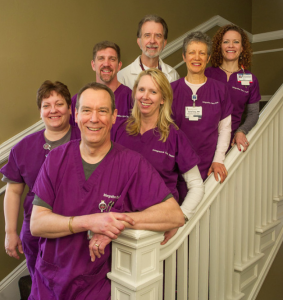
The Inpatient Integrative Care Team at the University of Maryland Medical Center. Team Lead Donna Audia, R.N., is second to the right in the first row. | Photographer, Coos Hamburger, University of Maryland Medical Center
In 2010, a 15-year-old boy, “Dave,” awaiting a heart transplant at the University of Maryland Medical Center (UMMC) made a somewhat unusual request: He wanted to have a massage. Without a therapist on staff, Inpatient Integrative Care Team Lead Donna Audia, R.N., stepped in, and for the next several months offered Dave basic massage techniques she had learned in nursing school. Apparently, her touch made an impression, since years later, Dave recalled the holistic medicine he received as a bright spot during an otherwise trying time in his life, in a conversation he had with Audia.
Holistic Medicine
Audia’s transition into holistic medicine began in 2006. The Center for Integrative Medicine (CIM), part of the University of Maryland School of Medicine, in collaboration with the University of Maryland’s R. Adams Cowley Shock Trauma Center, was using acupuncture to reduce inflammation in trauma patients; however, integrating Western and Eastern medicine caused some miscommunication. Audia became a bridge between the two modalities. “I learned reiki, and it changed how I approached the patient,” she said.
In the ensuing years, the inpatient integrative medicine team of one has grown and now offers a range of holistic medicine services throughout UMMC’s 757-bed facility. Other staff includes an expressive arts specialist; therapeutic musicians who play Celtic harp, guitar and keyboard; a M.D. who also provides acupuncturist; and a sound therapist. In addition to her reiki certification, Audia trained with pediatric massage specialist Tina Allen, L.M.T., C.P.M.M.T., C.P.M.T., C.I.M.T, to enhance her massage skills.
Part of holistic medicine involves teaching patients their ABCs—awareness, breathing and comfort—Audia said, as these techniques attempt to center the patient, making them feel safe and loved. “We hold their hands and ask them to think of being home, walking their dog, holding their loved one’s hand,” she explained.
Although some of the staff was skeptical at first, when they saw how calm and relaxed the patients were following therapy, they quickly embraced the techniques, said Audia. At times, the medical staff is on the receiving end as well.
“When a nurse is having a bad day, we might sit down and use therapeutic listening, hold her hand or do hand massage,” Audia said. Once a month, the team gives a 10-minute, in-house presentation about holistic medicine services. Audia has spoken at national conferences in an effort to inform other health care practitioners of the benefits associated with integrative medicine.
The Whole Patient
Pain has emotional, spiritual and physical components, Audia said. “Integrative medicine involves the whole patient. Integrative means building a relationship between the practitioner and patient and the practitioner and the community,” she said.
“Patients don’t feel a connection when they are in the hospital,” Audia added. “I want them to know that when I come into the room, I am not just here to give meds or check their blood pressure. I’m checking on them as a human being. We are connected.”
About the Author
Phyllis Hanlon has written nonfiction articles and book reviews as well as human-interest stories, profiles and award-winning essays. Her specialty areas include health and medicine, religion, education and business. She regularly delights in the joys of massage. She has written many articles for MASSAGE Magazine, including “MT Amy Murry Keeps Olympic Athletes on Track.”